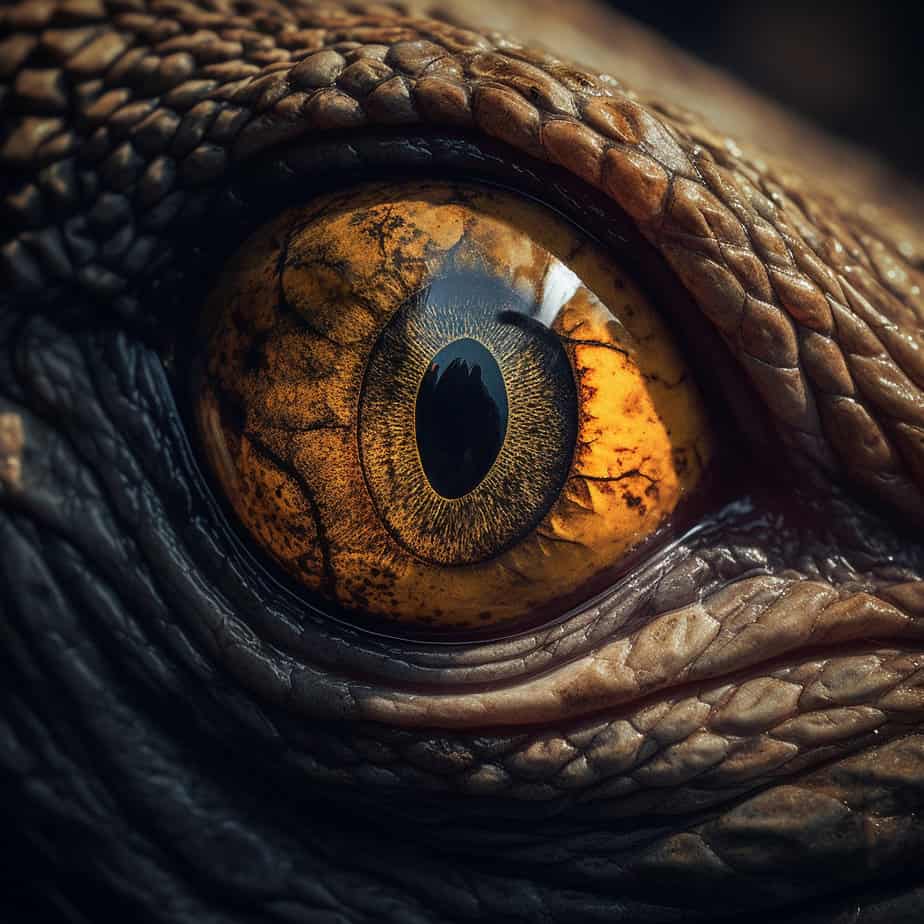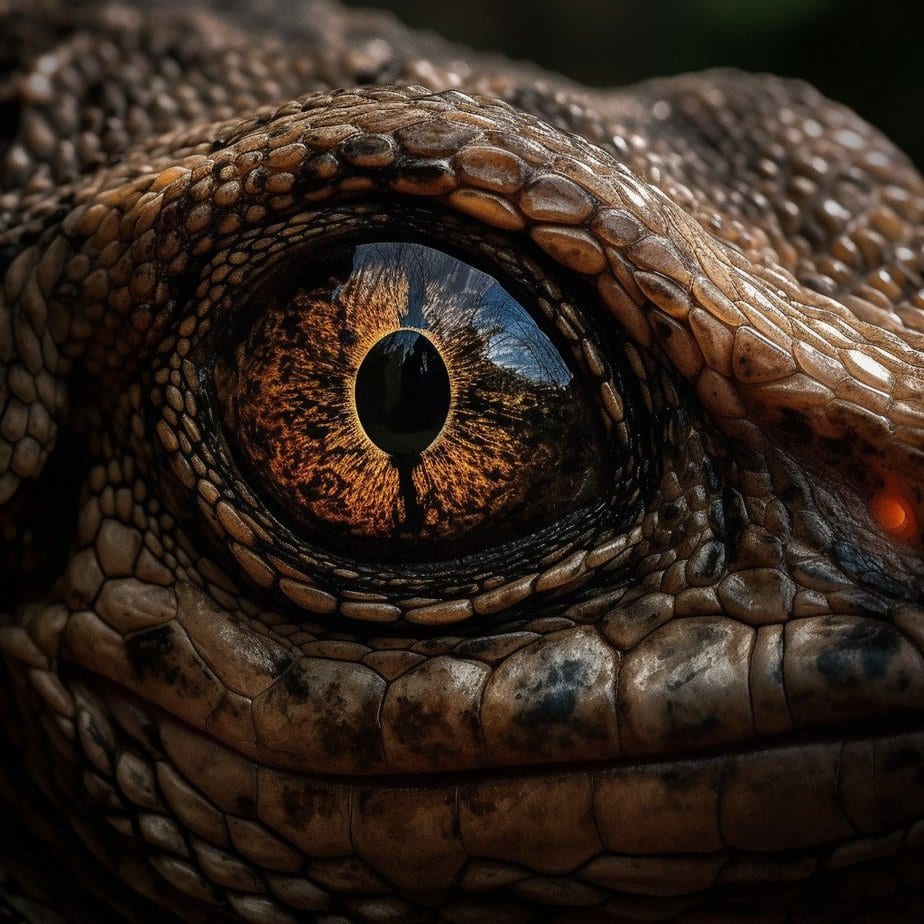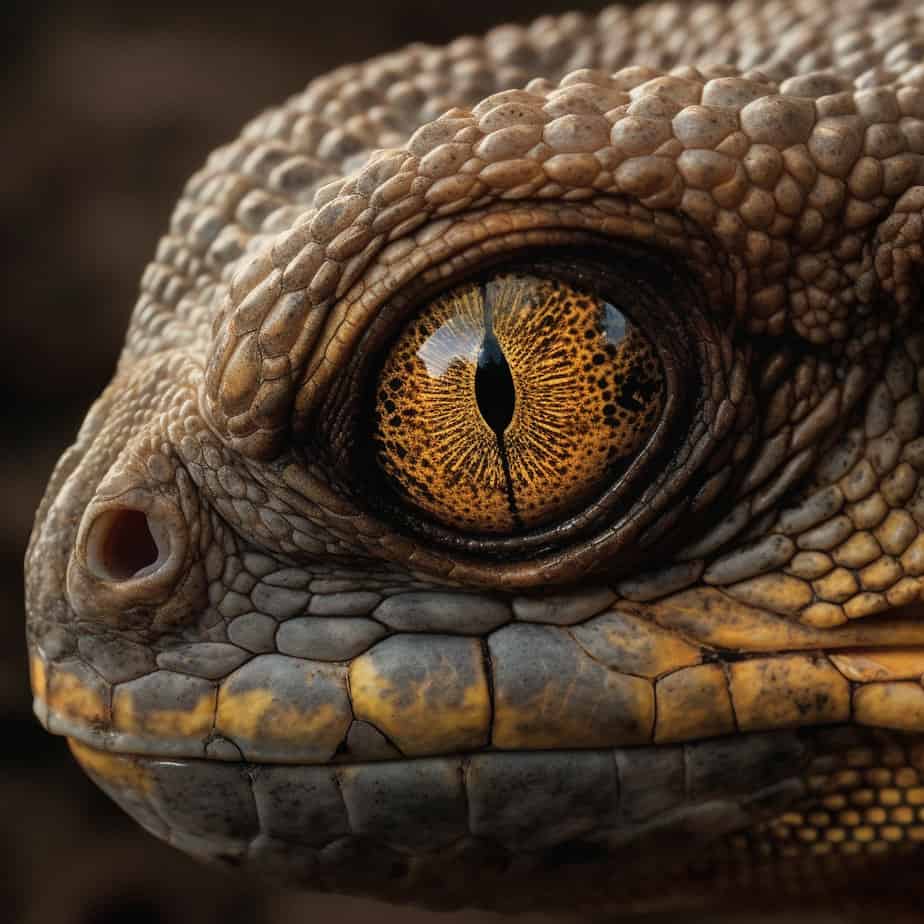The eyes of the Komodo dragon, the largest lizard species on Earth, are a fascinating aspect of its anatomy. These remarkable creatures have evolved unique visual adaptations that allow them to thrive in their natural habitat. From their keen eyesight to their ability to perceive colors and detect movement, the Komodo dragon’s eyes play a crucial role in its survival. In this article, we will delve into the intricacies of Komodo dragon eyes, exploring their structure, function, and the incredible adaptations that make them such formidable predators. So, let’s dive into the world of these captivating reptilian eyes and discover what makes them so extraordinary.
Key Takeaways
- Komodo dragons have excellent eyesight, allowing them to spot prey from long distances.
- They possess a unique combination of color vision and sensitivity to motion.
- Their eyes are well-adapted for hunting in both daylight and low-light conditions.
- Komodo dragons have a protective layer called the “spectacle” that covers their eyes, similar to a snake’s eye scale.
- Understanding the visual capabilities of Komodo dragons helps researchers study their behavior and ecology.
The Fascinating World of Komodo Dragon Eyes

A. A Close-Up Look at Komodo Dragon Eyes
When it comes to the animal kingdom, few creatures captivate our imagination quite like the Komodo dragon. These magnificent reptiles, native to the Indonesian islands, are known for their impressive size, powerful jaws, and venomous bite. But what about their eyes? Let’s take a closer look at the mesmerizing world of Komodo dragon eyes.
The eyes of a Komodo dragon are truly a sight to behold. Positioned on either side of their head, these large, round orbs provide them with a keen sense of vision. Like other reptiles, Komodo dragons have a third eyelid, known as a nictitating membrane, which helps protect their eyes from debris and harsh sunlight.
One of the most striking features of a Komodo dragon’s eyes is their color. These reptiles possess a unique color spectrum that ranges from yellow to orange, with hints of red and brown. This vibrant palette not only adds to their overall beauty but also serves a functional purpose in their environment.
B. The Unique Color Spectrum of Komodo Dragon Eyes
The distinct color spectrum of Komodo dragon eyes is a result of their specialized retinas. These retinas contain different types of photoreceptor cells, which are responsible for detecting and interpreting light. In the case of Komodo dragons, they have a higher number of red and green cones, allowing them to perceive a wider range of colors compared to humans.
This enhanced color vision is particularly advantageous for Komodo dragons when it comes to hunting. They can easily spot prey, such as deer or wild boar, amidst the dense vegetation of their habitat. Additionally, their ability to discern subtle color variations helps them blend into their surroundings, making them more effective predators.
C. Debunking Myths: Do Komodo Dragons Really Have Three Eyes?
You may have come across the popular myth that Komodo dragons have three eyes. While it would certainly be fascinating, this claim is nothing more than a misconception. Komodo dragons, like all reptiles, have two eyes just like humans and most other animals.
The confusion may arise from the presence of a small, sensory organ on the top of their head called the parietal eye. This specialized structure, also known as the “third eye,” is not a functioning eye in the traditional sense. Instead, it helps Komodo dragons regulate their body temperature and sense changes in light intensity.
In conclusion, the eyes of Komodo dragons are a marvel of nature. Their unique color spectrum and keen vision contribute to their success as apex predators. While they may not possess three eyes, their two eyes, along with the parietal eye, provide them with the tools they need to navigate their environment with precision and grace. So, the next time you encounter a Komodo dragon, take a moment to appreciate the beauty and complexity of their captivating eyes.
Unraveling the Mystery: The Third Eye of Komodo Dragons

A. The Truth Behind the Komodo Dragon’s Third Eye
When it comes to the fascinating world of reptiles, few creatures capture our imagination quite like the mighty Komodo dragon. These ancient reptiles, native to the Indonesian islands, possess a unique and mysterious feature known as the “third eye.” But what exactly is this third eye, and what purpose does it serve? Let’s delve into the truth behind the Komodo dragon’s enigmatic third eye.
Contrary to what its name suggests, the third eye of a Komodo dragon is not an actual functioning eye. Instead, it is a light-sensitive organ called the parietal eye, located on the top of its head. This small, circular structure is covered by a translucent scale and is often mistaken for a scale anomaly or a wart. The parietal eye is a remnant of the reptile‘s evolutionary past and is found in other reptiles as well, such as certain lizards and tuataras.
The parietal eye of the Komodo dragon is connected to the pineal gland, which plays a crucial role in regulating the reptile‘s circadian rhythm and hormone production. While it cannot form images like the primary eyes, the parietal eye can detect changes in light intensity and aid in thermoregulation. This unique adaptation allows Komodo dragons to bask in the sun and maintain their body temperature efficiently.
B. The Functionality and Adaptation of the Third Eye
The parietal eye of the Komodo dragon serves several important functions that contribute to its survival in the wild. One of its primary roles is to help regulate the reptile‘s daily activities. By sensing changes in light, the third eye can determine the time of day, allowing the Komodo dragon to adjust its behavior accordingly. This ability is especially crucial for these apex predators, as it helps them optimize their hunting and mating strategies.
In addition to its role in circadian rhythm regulation, the third eye also aids in detecting potential threats. As a predator, the Komodo dragon relies on its keen senses to locate prey and avoid danger. The parietal eye’s sensitivity to light changes enables the reptile to be more aware of its surroundings, enhancing its overall situational awareness. This heightened awareness is particularly advantageous in the dense forests and grasslands where Komodo dragons reside.
Another fascinating aspect of the third eye’s functionality is its involvement in thermoregulation. Komodo dragons are ectothermic creatures, meaning they rely on external heat sources to regulate their body temperature. The parietal eye helps them gauge the intensity of sunlight, allowing them to position themselves optimally for basking. By absorbing the sun‘s rays, Komodo dragons can raise their body temperature and become more active, enhancing their hunting capabilities.
In conclusion, while the third eye of Komodo dragons may not possess the same visual capabilities as their primary eyes, it serves a crucial role in their survival and adaptation. This light-sensitive organ aids in regulating their circadian rhythm, enhancing their situational awareness, and optimizing their thermoregulation. The enigmatic third eye of the Komodo dragon is a testament to the remarkable adaptations that have allowed these ancient reptiles to thrive in their unique island habitats.
The Biological Marvel: Anatomy of Komodo Dragon Eyes
A. A Detailed Eye Diagram of Komodo Dragons
The eyes of Komodo dragons are truly fascinating. These majestic creatures possess a set of eyes that are perfectly adapted to their environment and hunting habits. Let’s take a closer look at the intricate anatomy of their eyes.
The Structure of Komodo Dragon Eyes
Komodo dragon eyes are similar to those of other reptiles, but they have some unique features. The eyes are positioned on the sides of their heads, providing them with a wide field of vision. This allows them to spot potential prey or threats from various angles.
The size of a Komodo dragon’s eye is also worth noting. They have relatively large eyes compared to their body size, which aids in their ability to detect movement and spot prey from a distance. The eyes are protected by a bony ring called the sclerotic ring, which provides additional support and protection.
The Pupil and Iris
One of the most striking features of Komodo dragon eyes is their pupil. Unlike humans, who have round pupils, Komodo dragons have vertical, slit-like pupils. This unique shape allows them to control the amount of light entering their eyes, making them highly adaptable to different lighting conditions.
The color of a Komodo dragon’s iris can vary, ranging from yellow to orange. This adds to their overall aesthetic appeal and makes them even more captivating to observe.
The Retina and Vision
The retina, located at the back of the eye, is responsible for capturing light and converting it into electrical signals that can be interpreted by the brain. Komodo dragons have a high number of rod cells in their retinas, which are specialized for low-light conditions. This adaptation gives them excellent night vision, allowing them to hunt effectively in the dark.
B. Understanding the Eye Adaptations of Komodo Dragons
Komodo dragons have evolved a set of remarkable eye adaptations that enable them to thrive in their natural habitat. Let’s delve deeper into these adaptations and explore how they contribute to the dragon’s hunting prowess.
Binocular Vision
While Komodo dragons primarily rely on their sense of smell to locate prey, they also possess a degree of binocular vision. This means that their eyes can focus on the same object simultaneously, providing them with depth perception. Binocular vision is especially useful when the dragon is closing in on its prey, allowing for precise strikes.
Eye Health and Care
Maintaining healthy eyes is crucial for Komodo dragons, as any impairment could hinder their ability to hunt and survive. These reptiles have a transparent protective scale called a spectacle that covers their eyes, keeping them safe from debris and potential injuries. The spectacle also helps retain moisture, preventing the eyes from drying out in the arid environments they inhabit.
Komodo dragons also possess a unique ability to regenerate damaged tissue, including their eyes. If they sustain an injury, their body can initiate a healing process that repairs the damaged area. This remarkable regenerative ability ensures that their eyes remain in optimal condition for hunting and survival.
Predator Vision
Komodo dragons are apex predators, and their eyes play a crucial role in their hunting strategies. Their exceptional eyesight allows them to spot even the slightest movement from a considerable distance. This gives them an advantage when stalking prey, as they can patiently wait for the perfect moment to strike.
In addition to their acute vision, Komodo dragons also possess an incredible sense of smell, which complements their hunting abilities. This combination of sensory adaptations makes them formidable predators in their ecosystem.
In conclusion, the eyes of Komodo dragons are a marvel of biological adaptation. Their unique anatomy, including the structure of their eyes, the shape of their pupils, and their exceptional night vision, allows them to thrive in their natural habitat. These adaptations, along with their binocular vision and regenerative abilities, contribute to their success as apex predators. Understanding the intricate details of Komodo dragon eyes provides us with a deeper appreciation for the wonders of nature.
The Vision of Komodo Dragons: More Than Meets the Eye

A. The Color Perception of Komodo Dragon Eyes
Komodo dragons, the largest lizards on Earth, possess a remarkable set of sensory organs, including their eyes. These reptiles have evolved unique visual capabilities that allow them to navigate their environment and locate prey with astonishing precision. While their eyes may not be as colorful as those of birds or mammals, they are perfectly adapted to the Komodo dragon’s natural habitat.
Unlike humans, who have three types of color receptors (cones) in their eyes, Komodo dragons only have two types of cones. This means that their color perception is somewhat limited compared to ours. However, this doesn’t mean that Komodo dragons see the world in black and white. They can still perceive a range of colors, albeit with a different level of vibrancy.
Research suggests that Komodo dragons are particularly sensitive to shades of blue and green. These colors are prevalent in their natural surroundings, such as the lush vegetation and clear waters of their island habitats. By being attuned to these hues, Komodo dragons can effectively blend into their environment, making it easier for them to ambush unsuspecting prey.
B. The Role of Blood in Komodo Dragon Vision
One fascinating aspect of Komodo dragon eyes is their ability to detect and perceive blood. These reptiles have a heightened sensitivity to the scent of blood, which plays a crucial role in their hunting strategy. When a Komodo dragon bites its prey, it inflicts a deep wound that causes profuse bleeding. The dragon then relies on its acute sense of smell to track the injured animal, even if it manages to escape.
But how does blood detection relate to their vision? Well, recent studies have shown that Komodo dragons possess a specialized protein in their eyes called “Vasotocin.” This protein is responsible for increasing blood flow to the retina, enhancing the dragon’s ability to detect and track the scent of blood. This adaptation gives them a distinct advantage when hunting injured or weakened prey, making them formidable predators in their ecosystem.
C. The Sight Capabilities of Komodo Dragons
While Komodo dragons may not have the sharpest vision among reptiles, they have developed other visual adaptations that make them highly efficient hunters. One such adaptation is their ability to see in low light conditions, which is crucial for their nocturnal hunting habits.
Komodo dragons have large pupils that can dilate and contract to regulate the amount of light entering their eyes. This allows them to adjust their vision according to the ambient light levels, ensuring they can see clearly even in dimly lit environments. Additionally, their eyes are equipped with a layer of cells called “tapetum lucidum,” which reflects light back through the retina, maximizing their ability to capture available light and enhancing their night vision.
Another remarkable feature of Komodo dragon eyes is their ability to focus independently. Each eye can move separately, allowing the dragon to have a wider field of view and spot potential threats or prey from different angles. This binocular vision, combined with their acute sense of smell and hearing, gives Komodo dragons a comprehensive understanding of their surroundings, making it difficult for anything to escape their attention.
In conclusion, the eyes of Komodo dragons are a marvel of evolution. While their color perception may be different from ours, they are perfectly suited to their natural habitat. Their ability to detect and track the scent of blood, along with their exceptional night vision and independent eye movement, make them formidable predators. These adaptations have allowed Komodo dragons to thrive in their unique island ecosystems for millions of years, ensuring their place as one of nature’s most fascinating creatures.
Interesting Facts About Komodo Dragon Eyes
Komodo dragons, the largest lizards on Earth, possess fascinating eyes that are well adapted to their environment. Let’s explore some intriguing facts about these remarkable reptilian eyes.
Unique Eye Structure
The eyes of Komodo dragons are a marvel of evolution. They have a distinct structure that sets them apart from other reptiles. Unlike most lizards, Komodo dragons have a keen sense of vision, allowing them to spot prey from a considerable distance.
Excellent Vision
Komodo dragons have excellent eyesight, enabling them to locate their next meal with precision. Their eyes are specially adapted for daytime hunting, as they possess a high number of cone cells in their retinas. This abundance of cone cells allows them to perceive colors more vividly than many other reptiles.
Binocular Vision
Similar to humans, Komodo dragons have binocular vision. This means that their eyes are positioned on the front of their heads, providing them with overlapping fields of view. This binocular vision allows them to accurately judge distances, which is crucial for successful hunting.
Night Vision
While Komodo dragons primarily hunt during the day, they also possess some degree of night vision. Their eyes contain specialized cells called rods, which are highly sensitive to low levels of light. This adaptation allows them to navigate and hunt in dimly lit conditions, giving them an advantage over their prey.
Protective Eyelids
To protect their eyes from debris and potential injuries during hunting and feeding, Komodo dragons have a unique set of eyelids. They possess both upper and lower eyelids, which close horizontally rather than vertically. This horizontal closure helps shield their eyes from dust, dirt, and even the thrashing movements of their prey.
Eye Color
The eye color of Komodo dragons varies depending on their age. Juvenile Komodo dragons have bright green eyes, which gradually transition to a yellowish color as they mature. This change in eye color is thought to be related to their growth and development.
Impressive Size
Just like the rest of their body, the eyes of Komodo dragons are also large in size. Their eyes can measure up to 2.5 centimeters (1 inch) in diameter, allowing them to capture as much light as possible for optimal vision.
Acute Sense of Smell
While not directly related to their eyes, it is worth mentioning that Komodo dragons have an exceptional sense of smell. Their forked tongues pick up scent particles from the air, which they then transfer to a specialized organ in the roof of their mouths called the Jacobson’s organ. This organ helps them detect prey, locate carrion, and even find potential mates.
In conclusion, Komodo dragon eyes are a remarkable example of nature’s ingenuity. Their unique structure, excellent vision, binocular capabilities, night vision, protective eyelids, changing eye color, large size, and acute sense of smell all contribute to their success as apex predators. Understanding the intricacies of their eyes helps us appreciate the fascinating adaptations that have allowed these incredible creatures to thrive in their natural habitat. Conclusion
In conclusion, the eyes of the Komodo dragon are truly remarkable. These large reptiles have evolved unique adaptations to their visual system, allowing them to thrive in their natural habitat. With their keen eyesight, they are able to detect movement from great distances, making them formidable hunters. The presence of a nictitating membrane protects their eyes from debris and potential injuries during their aggressive feeding behaviors. Additionally, their ability to see in color helps them navigate their environment and identify potential prey. The combination of these adaptations makes the eyes of the Komodo dragon a fascinating aspect of their biology. Understanding the intricacies of their visual system not only sheds light on their evolutionary history but also highlights the incredible diversity of life on our planet. So, the next time you encounter a Komodo dragon, take a moment to appreciate the beauty and complexity of their eyes.
Frequently Asked Questions
1. What colour are komodo dragons eyes?
Komodo dragons typically have eyes that are a deep yellow or gold color. This coloration helps them to blend in with their natural environment.
2. Does a komodo dragon have three eyes?
No, Komodo dragons do not have three eyes. They have two eyes like most vertebrates. The concept of a third eye is a myth and is not supported by scientific evidence.
3. What are some unique komodo dragon eye adaptations?
Komodo dragons have several unique eye adaptations. They have a vertical slit pupil that allows for a wide range of light control. They also have a nictitating membrane, or a third eyelid, that protects the eye and keeps it clean while the dragon is hunting or feeding.
4. Can you provide a komodo dragon eye diagram?
Unfortunately, as an AI, I’m unable to provide diagrams. However, a Komodo dragon’s eye structure is similar to other lizards, with a cornea, lens, retina, and a vertical slit pupil. They also have a nictitating membrane, often referred to as a third eyelid.
5. What are some interesting komodo dragon eyes facts?
Komodo dragons have excellent vision. They can see objects as far away as 300 meters. Their eyes are also adapted to their hunting lifestyle, with a vertical slit pupil that can adjust to different levels of light.
6. What is the size of a komodo dragon’s eye?
The exact size of a Komodo dragon’s eye is not well-documented, but it is proportionate to their body size. The eyes are small compared to their overall body size.
7. How is the vision in large lizards like the Komodo dragon?
Large lizards like the Komodo dragon have excellent vision. They can see objects as far away as 300 meters. This keen vision aids them in hunting and navigating their environment.
8. What is the structure of a dragon’s eye?
The structure of a dragon’s eye, specifically a Komodo dragon, includes a cornea, lens, retina, and a vertical slit pupil. They also have a nictitating membrane, or a third eyelid, that protects the eye and keeps it clean.
9. How is the eye adaptation in reptiles like the Komodo dragon?
Reptiles like the Komodo dragon have eyes that are well-adapted to their environment. They have a vertical slit pupil that can adjust to different levels of light, and a nictitating membrane that protects the eye during hunting or feeding.
10. How is the Komodo dragon’s night vision?
Komodo dragons have good night vision. Their vertical slit pupils can open wide in low light conditions, allowing them to see effectively at night. This is especially useful for hunting and navigating their environment after dark.




